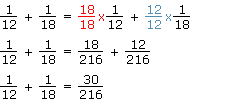PROBLEM
Which of the following fractions is larger?
SOLUTION ONE (USING THE LOWEST COMMON DENOMINATOR)
Re-write the fractions wich a lowest common denominator of 60.
SOLUTION TWO (USING A DIFFERENT COMMON DENOMINATOR)
Any multiple of 60 can be used as a common denominator. The product of the denominators of the fractions (15x20 = 300) can be used as 300 is a multiple of 60.
PROBLEM
What is the sum of the following?
SOLUTION ONE (USING THE LOWEST COMMON DENOMINATOR)
Re-write the fractions wich a lowest common denominator of 36.
SOLUTION TWO (USING A DIFFERENT COMMON DENOMINATOR)
Any multiple of 36 can be used as a common denominator. The product of the denominators of the fractions (12x18 = 216) can be used as 216 is a multiple of 36.
Usually fractions are displayed in reduced form, so both 30 and 216 will be divided by 6, the greatest common factor of 30 and 216.










